使用Numpy和Scipy处理图像
图像 = 2-D 数值数组(或者 3-D: CT, MRI, 2D + 时间; 4-D, ...)这里 图像 == Numpy数组 np.array这个教程中使用的工具:
numpy:基本数组操作
scipy:
scipy.ndimage子模块致力于图像处理(n维图像)。参见http://docs.scipy.org/doc/scipy/reference/tutorial/ndimage.htmlfrom scipy import ndimage一些例子用到了使用np.array的特殊的工具箱:
Scikit Image
scikit-learn
图像中的常见问题有:
输入/输出,呈现图像
基本操作:裁剪、翻转、旋转……
图像滤镜:消噪,锐化
图像分割:不同对应对象的像素标记
更有力和完整的模块:
OpenCV (Python绑定)
CellProfiler
ITK,Python绑定
更多……
目录
打开和读写图像文件
呈现图像
基本操作
统计信息
几何转换
图像滤镜
模糊/平滑
锐化
消噪
数学形态学
特征提取
边缘检测
分割
测量对象属性:ndimage.measurements
Footnotes
打开和读写图像文件
将一个数组写入文件:
In [1]: from scipy import miscIn [2]: l = misc.lena()In [3]: misc.imsave('lena.png', l) # uses the Image module (PIL)In [4]: import pylab as plIn [5]: pl.imshow(l)
Out[5]: <matplotlib.image.AxesImage at 0x4118110>从一个图像文件创建数组:
In [7]: lena = misc.imread('lena.png')In [8]: type(lena)
Out[8]: numpy.ndarrayIn [9]: lena.shape, lena.dtype
Out[9]: ((512, 512), dtype('uint8'))8位图像(0-255)的dtype是uint8
打开一个raw文件(相机, 3-D图像)
In [10]: l.tofile('lena.raw') # 创建一个raw文件In [14]: lena_from_raw = np.fromfile('lena.raw', dtype=np.int64)In [15]: lena_from_raw.shape
Out[15]: (262144,)In [16]: lena_from_raw.shape = (512, 512)In [17]: import osIn [18]: os.remove('lena.raw')需要知道图像的shape和dtype(如何区分隔数据字节)
对于大数据,使用np.memmap进行内存映射:
In [21]: lena_memmap = np.memmap('lena.raw', dtype=np.int64, shape=(512,512))(数据从文件读取,而不是载入内存)
处理一个列表的图像文件:
In [22]: for i in range(10):....: im = np.random.random_integers(0, 255, 10000).reshape((100, 100))....: misc.imsave('random_%02d.png' % i, im)....: In [23]: from glob import globIn [24]: filelist = glob('random*.png')In [25]: filelist.sort()呈现图像
使用matplotlib和imshow将图像呈现在matplotlib图像(figure)中:
In [29]: l = misc.lena()In [30]: import matplotlib.pyplot as pltIn [31]: plt.imshow(l, cmap=plt.cm.gray)
Out[31]: <matplotlib.image.AxesImage at 0x4964990>通过设置最大最小之增加对比:
In [33]: plt.imshow(l, cmap=plt.cm.gray, vmin=30, vmax=200)
Out[33]: <matplotlib.image.AxesImage at 0x50cb790>In [34]: plt.axis('off') # 移除axes和ticks
Out[34]: (-0.5, 511.5, 511.5, -0.5)绘制等高线:1
ln[7]: plt.contour(l, [60, 211])更好地观察强度变化,使用interpolate=‘nearest’:
In [7]: plt.imshow(l[200:220, 200:220], cmap=plt.cm.gray)
Out[7]: <matplotlib.image.AxesImage at 0x3bbe610>In [8]: plt.imshow(l[200:220, 200:220], cmap=plt.cm.gray, interpolation='nearest')
Out[8]: <matplotlib.image.AxesImage at 0x3ed3250>其它包有时使用图形工具箱来可视化(GTK,Qt):2
In [9]: import skimage.io as im_ioIn [21]: im_io.use_plugin('gtk', 'imshow')In [22]: im_io.imshow(l)3-D可视化:Mayavi
参见可用Mayavi进行3-D绘图和体积数据
图形平面工具
等值面
……
基本操作
图像是数组:使用整个numpy机理。
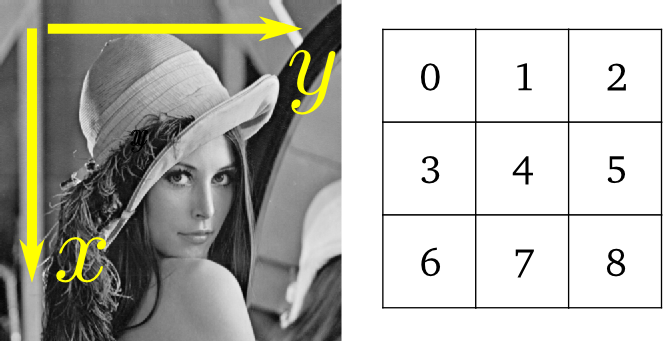
>>> lena = misc.lena()
>>> lena[0, 40]
166
>>> # Slicing
>>> lena[10:13, 20:23]
array([[158, 156, 157],
[157, 155, 155],
[157, 157, 158]])
>>> lena[100:120] = 255
>>>
>>> lx, ly = lena.shape
>>> X, Y = np.ogrid[0:lx, 0:ly]
>>> mask = (X - lx/2)**2 + (Y - ly/2)**2 > lx*ly/4
>>> # Masks
>>> lena[mask] = 0
>>> # Fancy indexing
>>> lena[range(400), range(400)] = 255统计信息
>>> lena = scipy.lena()
>>> lena.mean()
124.04678344726562
>>> lena.max(), lena.min()
(245, 25)np.histogram
几何转换
>>> lena = scipy.lena()
>>> lx, ly = lena.shape
>>> # Cropping
>>> crop_lena = lena[lx/4:-lx/4, ly/4:-ly/4]
>>> # up <-> down flip
>>> flip_ud_lena = np.flipud(lena)
>>> # rotation
>>> rotate_lena = ndimage.rotate(lena, 45)
>>> rotate_lena_noreshape = ndimage.rotate(lena, 45, reshape=False)
示例源码
图像滤镜
局部滤镜:用相邻像素值的函数替代当前像素的值。
相邻:方形(指定大小),圆形, 或者更多复杂的_结构元素_。
模糊/平滑
scipy.ndimage中的_高斯滤镜_:
>>> from scipy import misc
>>> from scipy import ndimage
>>> lena = misc.lena()
>>> blurred_lena = ndimage.gaussian_filter(lena, sigma=3)
>>> very_blurred = ndimage.gaussian_filter(lena, sigma=5)均匀滤镜
>>> local_mean = ndimage.uniform_filter(lena, size=11)示例源码
锐化
锐化模糊图像:
>>> from scipy import misc
>>> lena = misc.lena()
>>> blurred_l = ndimage.gaussian_filter(lena, 3)通过增加拉普拉斯近似增加边缘权重:
>>> filter_blurred_l = ndimage.gaussian_filter(blurred_l, 1)
>>> alpha = 30
>>> sharpened = blurred_l + alpha * (blurred_l - filter_blurred_l)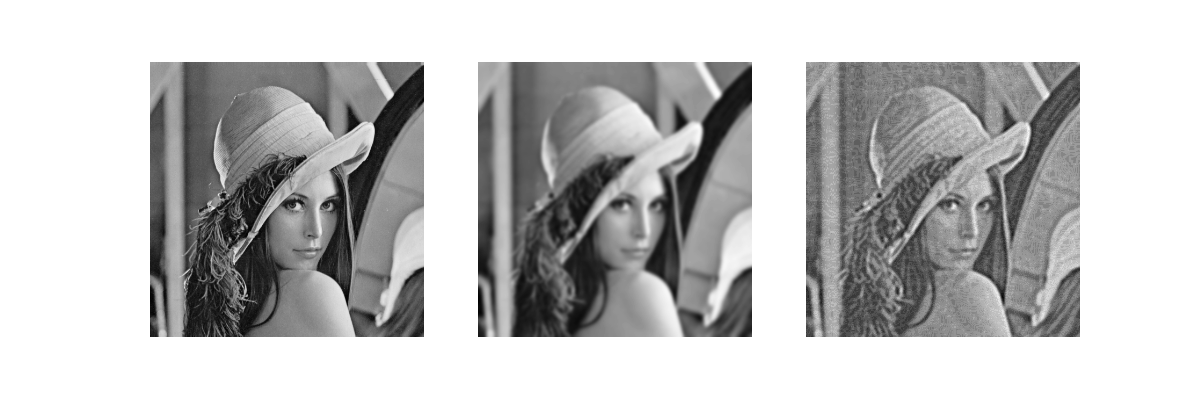
示例源码
消噪
向lena增加噪声:
>>> from scipy import misc
>>> l = misc.lena()
>>> l = l[230:310, 210:350]
>>> noisy = l + 0.4*l.std()*np.random.random(l.shape)_高斯滤镜_平滑掉噪声……还有边缘:
>>> gauss_denoised = ndimage.gaussian_filter(noisy, 2)大多局部线性各向同性滤镜都模糊图像(ndimage.uniform_filter)
_中值滤镜_更好地保留边缘:
>>> med_denoised = ndimage.median_filter(noisy, 3)
示例源码
中值滤镜:对直边界效果更好(低曲率):
>>> im = np.zeros((20, 20))
>>> im[5:-5, 5:-5] = 1
>>> im = ndimage.distance_transform_bf(im)
>>> im_noise = im + 0.2*np.random.randn(*im.shape)
>>> im_med = ndimage.median_filter(im_noise, 3)
示例源码
其它排序滤波器:ndimage.maximum_filter,ndimage.percentile_filter
其它局部非线性滤波器:维纳滤波器(scipy.signal.wiener)等
非局部滤波器
_总变差(TV)_消噪。找到新的图像让图像的总变差(正态L1梯度的积分)变得最小,当接近测量图像时:
>>> # from skimage.filter import tv_denoise
>>> from tv_denoise import tv_denoise
>>> tv_denoised = tv_denoise(noisy, weight=10)
>>> # More denoising (to the expense of fidelity to data)
>>> tv_denoised = tv_denoise(noisy, weight=50)总变差滤镜tv_denoise可以从skimage中获得,(文档:http://scikit-image.org/docs/dev/api/skimage.filter.html#denoise-tv),但是为了方便我们在这个教程中作为一个_单独模块_导入。

示例源码
数学形态学
参见:http://en.wikipedia.org/wiki/Mathematical_morphology
结构元素:
>>> el = ndimage.generate_binary_structure(2, 1)
>>> el
array([[False, True, False],[ True, True, True],[False, True, False]], dtype=bool)
>>> el.astype(np.int)
array([[0, 1, 0],[1, 1, 1],[0, 1, 0]])腐蚀 = 最小化滤镜。用结构元素覆盖的像素的最小值替代一个像素值:
>>> a = np.zeros((7,7), dtype=np.int)
>>> a[1:6, 2:5] = 1
>>> a
array([[0, 0, 0, 0, 0, 0, 0],[0, 0, 1, 1, 1, 0, 0],[0, 0, 1, 1, 1, 0, 0],[0, 0, 1, 1, 1, 0, 0],[0, 0, 1, 1, 1, 0, 0],[0, 0, 1, 1, 1, 0, 0],[0, 0, 0, 0, 0, 0, 0]])
>>> ndimage.binary_erosion(a).astype(a.dtype)
array([[0, 0, 0, 0, 0, 0, 0],[0, 0, 0, 0, 0, 0, 0],[0, 0, 0, 1, 0, 0, 0],[0, 0, 0, 1, 0, 0, 0],[0, 0, 0, 1, 0, 0, 0],[0, 0, 0, 0, 0, 0, 0],[0, 0, 0, 0, 0, 0, 0]])
>>> #Erosion removes objects smaller than the structure
>>> ndimage.binary_erosion(a, structure=np.ones((5,5))).astype(a.dtype)
array([[0, 0, 0, 0, 0, 0, 0],[0, 0, 0, 0, 0, 0, 0],[0, 0, 0, 0, 0, 0, 0],[0, 0, 0, 0, 0, 0, 0],[0, 0, 0, 0, 0, 0, 0],[0, 0, 0, 0, 0, 0, 0],[0, 0, 0, 0, 0, 0, 0]])
膨胀:最大化滤镜:
>>> a = np.zeros((5, 5))
>>> a[2, 2] = 1
>>> a
array([[ 0., 0., 0., 0., 0.],[ 0., 0., 0., 0., 0.],[ 0., 0., 1., 0., 0.],[ 0., 0., 0., 0., 0.],[ 0., 0., 0., 0., 0.]])
>>> ndimage.binary_dilation(a).astype(a.dtype)
array([[ 0., 0., 0., 0., 0.],[ 0., 0., 1., 0., 0.],[ 0., 1., 1., 1., 0.],[ 0., 0., 1., 0., 0.],[ 0., 0., 0., 0., 0.]])对灰度值图像也有效:
>>> np.random.seed(2)
>>> x, y = (63*np.random.random((2, 8))).astype(np.int)
>>> im[x, y] = np.arange(8)>>> bigger_points = ndimage.grey_dilation(im, size=(5, 5), structure=np.ones((5, 5)))>>> square = np.zeros((16, 16))
>>> square[4:-4, 4:-4] = 1
>>> dist = ndimage.distance_transform_bf(square)
>>> dilate_dist = ndimage.grey_dilation(dist, size=(3, 3), \
... structure=np.ones((3, 3)))
示例源码
开操作:腐蚀+膨胀:
应用:移除噪声
>>> square = np.zeros((32, 32))
>>> square[10:-10, 10:-10] = 1
>>> np.random.seed(2)
>>> x, y = (32*np.random.random((2, 20))).astype(np.int)
>>> square[x, y] = 1>>> open_square = ndimage.binary_opening(square)>>> eroded_square = ndimage.binary_erosion(square)
>>> reconstruction = ndimage.binary_propagation(eroded_square, mask=square)
示例源码
闭操作:膨胀+腐蚀
许多其它数学分形:击中(hit)和击不中(miss)变换,tophat等等。
特征提取
边缘检测
合成数据:
>>> im = np.zeros((256, 256))
>>> im[64:-64, 64:-64] = 1
>>>
>>> im = ndimage.rotate(im, 15, mode='constant')
>>> im = ndimage.gaussian_filter(im, 8)使用_梯度操作(Sobel)_来找到搞强度的变化:
>>> sx = ndimage.sobel(im, axis=0, mode='constant')
>>> sy = ndimage.sobel(im, axis=1, mode='constant')
>>> sob = np.hypot(sx, sy)
示例源码
canny滤镜
Canny滤镜可以从skimage中获取(文档),但是为了方便我们在这个教程中作为一个_单独模块_导入:
>>> #from skimage.filter import canny
>>> #or use module shipped with tutorial
>>> im += 0.1*np.random.random(im.shape)
>>> edges = canny(im, 1, 0.4, 0.2) # not enough smoothing
>>> edges = canny(im, 3, 0.3, 0.2) # better parameters
示例源码
需要调整几个参数……过度拟合的风险
分割
基于_直方图_的分割(没有空间信息)
>>> n = 10>>> l = 256>>> im = np.zeros((l, l))>>> np.random.seed(1)>>> points = l*np.random.random((2, n**2))>>> im[(points[0]).astype(np.int), (points[1]).astype(np.int)] = 1>>> im = ndimage.gaussian_filter(im, sigma=l/(4.*n))>>> mask = (im > im.mean()).astype(np.float)>>> mask += 0.1 * im>>> img = mask + 0.2*np.random.randn(*mask.shape)>>> hist, bin_edges = np.histogram(img, bins=60)>>> bin_centers = 0.5*(bin_edges[:-1] + bin_edges[1:])>>> binary_img = img > 0.5

示例源码
自动阈值:使用高斯混合模型:
>>> mask = (im > im.mean()).astype(np.float)
>>> mask += 0.1 * im
>>> img = mask + 0.3*np.random.randn(*mask.shape)>>> from sklearn.mixture import GMM
>>> classif = GMM(n_components=2)
>>> classif.fit(img.reshape((img.size, 1)))
GMM(...)>>> classif.means_
array([[ 0.9353155 ],[-0.02966039]])
>>> np.sqrt(classif.covars_).ravel()
array([ 0.35074631, 0.28225327])
>>> classif.weights_
array([ 0.40989799, 0.59010201])
>>> threshold = np.mean(classif.means_)
>>> binary_img = img > threshold
使用数学形态学来清理结果:
>>> # Remove small white regions
>>> open_img = ndimage.binary_opening(binary_img)
>>> # Remove small black hole
>>> close_img = ndimage.binary_closing(open_img)
示例源码
练习
参看重建(reconstruction)操作(腐蚀+传播(propagation))产生比开/闭操作更好的结果:
>>> eroded_img = ndimage.binary_erosion(binary_img)
>>> reconstruct_img = ndimage.binary_propagation(eroded_img, mask=binary_img)
>>> tmp = np.logical_not(reconstruct_img)
>>> eroded_tmp = ndimage.binary_erosion(tmp)
>>> reconstruct_final = np.logical_not(ndimage.binary_propagation(eroded_tmp, mask=tmp))
>>> np.abs(mask - close_img).mean()
0.014678955078125
>>> np.abs(mask - reconstruct_final).mean()
0.0042572021484375练习
检查首次消噪步骤(中值滤波,总变差)如何更改直方图,并且查看是否基于直方图的分割更加精准了。
_基于图像_的分割:使用空间信息
>>> from sklearn.feature_extraction import image>>> from sklearn.cluster import spectral_clustering>>> l = 100>>> x, y = np.indices((l, l))>>> center1 = (28, 24)>>> center2 = (40, 50)>>> center3 = (67, 58)>>> center4 = (24, 70)>>> radius1, radius2, radius3, radius4 = 16, 14, 15, 14>>> circle1 = (x - center1[0])**2 + (y - center1[1])**2 < radius1**2>>> circle2 = (x - center2[0])**2 + (y - center2[1])**2 < radius2**2>>> circle3 = (x - center3[0])**2 + (y - center3[1])**2 < radius3**2>>> circle4 = (x - center4[0])**2 + (y - center4[1])**2 < radius4**2>>> # 4 circles>>> img = circle1 + circle2 + circle3 + circle4>>> mask = img.astype(bool)>>> img = img.astype(float)>>> img += 1 + 0.2*np.random.randn(*img.shape)>>> # Convert the image into a graph with the value of the gradient on>>> # the edges.>>> graph = image.img_to_graph(img, mask=mask)>>> # Take a decreasing function of the gradient: we take it weakly>>> # dependant from the gradient the segmentation is close to a voronoi>>> graph.data = np.exp(-graph.data/graph.data.std())>>> labels = spectral_clustering(graph, k=4, mode='arpack')>>> label_im = -np.ones(mask.shape)>>> label_im[mask] = labels
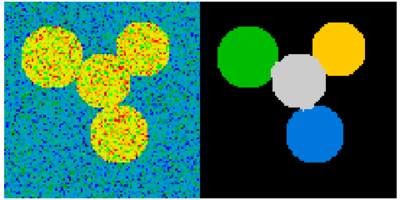
测量对象属性:ndimage.measurements
合成数据:
>>> n = 10
>>> l = 256
>>> im = np.zeros((l, l))
>>> points = l*np.random.random((2, n**2))
>>> im[(points[0]).astype(np.int), (points[1]).astype(np.int)] = 1
>>> im = ndimage.gaussian_filter(im, sigma=l/(4.*n))
>>> mask = im > im.mean()连接成分分析
标记连接成分:
ndimage.label>>> label_im, nb_labels = ndimage.label(mask)>>> nb_labels # how many regions?23>>> plt.imshow(label_im) <matplotlib.image.AxesImage object at ...>
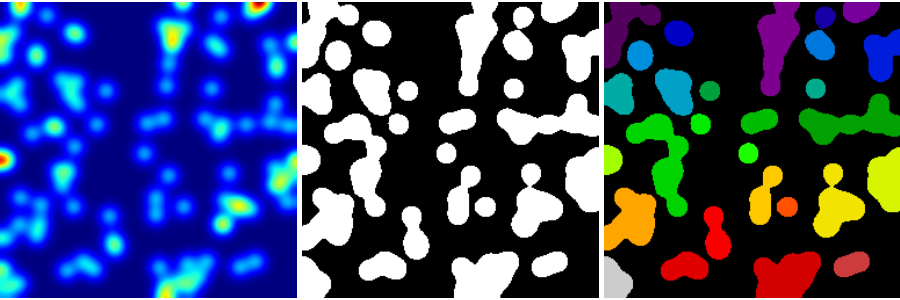
示例源码
计算每个区域的尺寸,均值等等:
>>> sizes = ndimage.sum(mask, label_im, range(nb_labels + 1))
>>> mean_vals = ndimage.sum(im, label_im, range(1, nb_labels + 1))计算小的连接成分:
>>> mask_size = sizes < 1000
>>> remove_pixel = mask_size[label_im]
>>> remove_pixel.shape
(256, 256)
>>> label_im[remove_pixel] = 0
>>> plt.imshow(label_im)
<matplotlib.image.AxesImage object at ...>现在使用np.searchsorted重新分配标签:
>>> labels = np.unique(label_im)
>>> label_im = np.searchsorted(labels, label_im)
示例源码
找到关注的封闭对象区域:3
>>> slice_x, slice_y = ndimage.find_objects(label_im==4)[0]
>>> roi = im[slice_x, slice_y]
>>> plt.imshow(roi)
<matplotlib.image.AxesImage object at ...>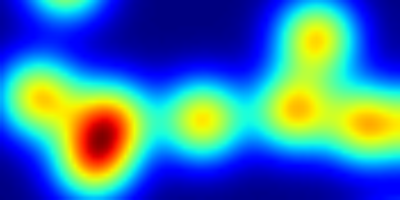
示例源码
其它空间测量:ndiamge.center_of_mass,ndimage.maximum_position等等。
可以在分割应用限制范围之外使用。
示例:块平均(block mean):
m scipy import misc
>>> l = misc.lena()
>>> sx, sy = l.shape
>>> X, Y = np.ogrid[0:sx, 0:sy]
>>> regions = sy/6 * (X/4) + Y/6 # note that we use broadcasting
>>> block_mean = ndimage.mean(l, labels=regions, index=np.arange(1,
... regions.max() +1))
>>> block_mean.shape = (sx/4, sy/6)
示例源码
当区域不是正则的4块状时,使用stride技巧更有效(示例:fake dimensions with strides)
非正则空间(Non-regular-spaced)区块:径向平均:
>>> sx, sy = l.shape
>>> X, Y = np.ogrid[0:sx, 0:sy]
>>> r = np.hypot(X - sx/2, Y - sy/2)
>>> rbin = (20* r/r.max()).astype(np.int)
>>> radial_mean = ndimage.mean(l, labels=rbin, index=np.arange(1, rbin.max() +1))
示例源码
其它测量
相关函数,傅里叶/小波谱等。
一个使用数学形态学的例子:粒度(http://en.wikipedia.org/wiki/Granulometry_%28morphology%29)
>>> def disk_structure(n):
... struct = np.zeros((2 * n + 1, 2 * n + 1))
... x, y = np.indices((2 * n + 1, 2 * n + 1))
... mask = (x - n)**2 + (y - n)**2 <= n**2
... struct[mask] = 1
... return struct.astype(np.bool)
...
>>>
>>> def granulometry(data, sizes=None):
... s = max(data.shape)
... if sizes == None:
... sizes = range(1, s/2, 2)
... granulo = [ndimage.binary_opening(data, \
... structure=disk_structure(n)).sum() for n in sizes]
... return granulo
...
>>>
>>> np.random.seed(1)
>>> n = 10
>>> l = 256
>>> im = np.zeros((l, l))
>>> points = l*np.random.random((2, n**2))
>>> im[(points[0]).astype(np.int), (points[1]).astype(np.int)] = 1
>>> im = ndimage.gaussian_filter(im, sigma=l/(4.*n))
>>>
>>> mask = im > im.mean()
>>>
>>> granulo = granulometry(mask, sizes=np.arange(2, 19, 4))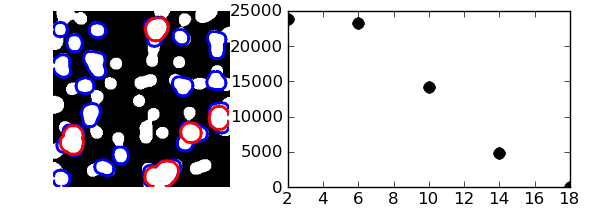
示例源码
Footnotes
占位 ↩
ValueError: can not convert int64 to uint8. ↩
根据以上操作剩下的区域选择区域,因为是随机生成可能结果不通,label_im==4未必留下来了。 ↩
正则空间 ↩
使用Numpy和Scipy处理图像相关推荐
- Github上Pandas,Numpy和 Scipy三个库中20个最常用的函数
首发于Datartisan数据工匠 写文章 Github上Pandas,Numpy和 Scipy三个库中20个最常用的函数 Datartisan 9 个月前 几个月前,我看到一篇博客中列出了 Gith ...
- 使用Numpy和Opencv完成图像的基本数据分析(Part III)
引言 本文是使用python进行图像基本处理系列的第三部分,在本人之前的文章里介绍了一些非常基本的图像分析操作,见文章<使用Numpy和Opencv完成图像的基本数据分析Part I>和& ...
- 【OpenCV 例程200篇】53. Scipy 实现图像二维卷积
[OpenCV 例程200篇]53. Scipy 实现图像二维卷积 欢迎关注 『OpenCV 例程200篇』 系列,持续更新中 欢迎关注 『Python小白的OpenCV学习课』 系列,持续更新中 滤 ...
- python用numpy生成图片并保存_python 实现将Numpy数组保存为图像
python 实现将Numpy数组保存为图像 第一种方案 可以使用scipy.misc,代码如下: import scipy.misc misc.imsave('out.jpg', image_arr ...
- 为python安装numpy和scipy(federo)
为了进行数值计算,例如积分等等,需要安装numpy和scipy,其中scipy是依赖于numpy的,所以先要装numpy. 1, 通过下载http://pypi.python.org/pypi/num ...
- python使用matplotlib可视化、使用matplotlib可视化scipy.misc图像、自定义使用grey灰色映射、将不同亮度映射到不同的色彩、并添加颜色标尺
python使用matplotlib可视化.使用matplotlib可视化scipy.misc图像.自定义使用grey灰色映射.将不同亮度映射到不同的色彩.并添加颜色标尺 目录
- python使用matplotlib可视化、使用matplotlib可视化scipy.misc图像、自定义使用RdYIBu色彩映射、将不同亮度映射到不同的色彩
python使用matplotlib可视化.使用matplotlib可视化scipy.misc图像.自定义使用RdYIBu色彩映射.将不同亮度映射到不同的色彩 目录
- python使用matplotlib可视化、使用matplotlib可视化scipy.misc图像、自定义使用winter色彩映射、将不同亮度映射到不同的色彩
python使用matplotlib可视化.使用matplotlib可视化scipy.misc图像.自定义使用winter色彩映射.将不同亮度映射到不同的色彩 目录
- python使用matplotlib可视化、使用matplotlib可视化scipy.misc图像、自定义使用Accent色彩映射、将不同亮度映射到不同的色彩
python使用matplotlib可视化.使用matplotlib可视化scipy.misc图像.自定义使用Accent色彩映射.将不同亮度映射到不同的色彩 目录
最新文章
- 经常使用的eclipse插件
- 【WPF】如何使用wpf实现屏幕最前端的绘图?
- 图解TCP协议中的三次握手和四次挥手
- mysql 事务权限_0428-mysql(事务、权限)
- 计算机一级怎么描述,计算机一级「关于RGB正确的描述的是」相关单选题
- 中国大学慕课计算机专业导论,2015秋计算机专业导论(大连大学)
- 六轴机器人轨迹规划之matlab画直线
- 股票回测Web应用开发
- 挂马攻击的介绍和防御
- Qt - 菜单栏、工具栏、状态栏(菜单栏、工具栏、状态栏添加方法)
- 简述python模块
- js dom节点操作的增加和删除
- nginx配置反向代理验证ssl证书 双向认证
- NotePad++7.5 64 bit版本以后没有plugin manger的解决方法
- GameBuilder开发游戏应用系列之60行代码实现FlappyBird
- @Validated和@Valid 解决list校验问题
- 网络舆情分析关键词怎么获取的系统平台方法
- 数据对比中的颜色配置(红绿)
- java 时间判断大小_java判断时间大小
- 安卓开发资料大集合,很多都是51CTO中的推荐材料,值得学习
热门文章
- 如何改变android5.1音量进度条,HTML5音频audio属性
- 让你android手机变平板,手机瞬间变平板 两种形态随意换_手机Android频道-中关村在线...
- Modeling Filters and Whitening Filters
- 对称加密与非对称加密
- 十分钟用Windows服务器简单搭建DHCP中继代理!!
- HTTP详解(1)-工作原理【转】
- 微信支付提示 缺少$key0$错误
- 网络上可供测试的Web Service
- Missing separate debuginfos, use: debuginfo-install
- 同时更改一条数据_数据库中的引擎、事务、锁、MVCC(二)
